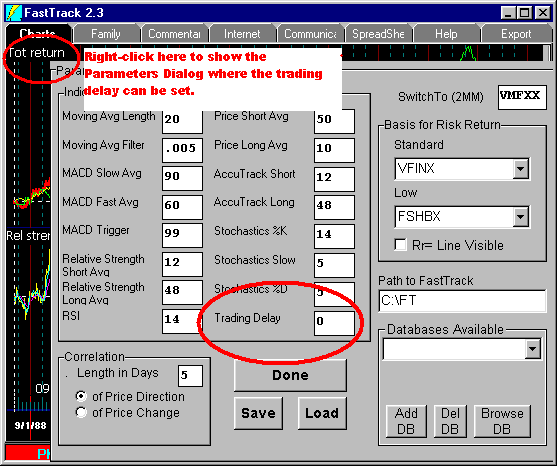Change the Trading Delay
Show the Parameters dialog box by
clicking on the chart and pressing <U> or right-clicking on the chart name and
choosing "Parameters" from the pop-up menu. If you typically make decisions
based on today's trading and can call in your trade before the market closes, then set
both BUY and SELL delay to 0. If you believe that your special insight will lead to a
decision a day sooner than the signal, then set the delay to -1 (yes, a negative number).
Comparison to Weekly Charting
Weekly charting has a lot of followers, A signal on Monday
may be reversed by Friday preventing a whipsaw. Unfortunately, as the week goes
on, weekly trading loses its value. With FastTrack's trade delay, every signal
gets 5-trading days to reverse itself. This style of trading is more effective
than waiting till the following Monday to make trades from Friday's signals.
AccuTrack Practical Application
Unlike timing indicators, AccuTrack is not highly sensitive to trading
delays. Setting the trading delay to a modest value, like 5,
can reduce whipsaws without sacrificing return in many cases. This is another argument for
the relative strength trading . . . you have longer to make up your mind.
Can I wait a while to see if it's a good signal?
Not every investor will make his decision to trade immediately. This
can have a dramatic impact on the success of your trading strategy. Conservative
investments are forgiving of delays. Since they move more slowly, you can take more time
to make your decision.
Moving average (V Chart and P Chart) is particularly sensitive to trading delays because its
signals are generated by breaking a trend. Usually half the move will happen very quickly
after a moving average's signal. Don't delay taking a moving average signal . . . or don't
use moving averages.
Signals generated by MACD are less sensitive to trading
delays. One of the most common complaints about MACD is that it gives the
right signal too early. Trading delays may be quite useful.
FastTrack will show you the impact of decision delays so you can shape
your investing strategies accordingly.
The Impact of Trading Delay on the J and 2 Charts
The J and 2 charts evaluate the success or
failure of a set of indicator signals. The trading delay has a substantial impact, often
positive - on the success of a signal set. For more details see the
discussion on signals.
Within FTRebalance, you can use trade delays in
backtesting, but there is no support for real-time trade delays. When you
click the Run button you get the recommended changes including the most
recent closing prices. If you impose a trade delay and modify the models
trading decisions, this is a manual exercise without Model assistance.
|
